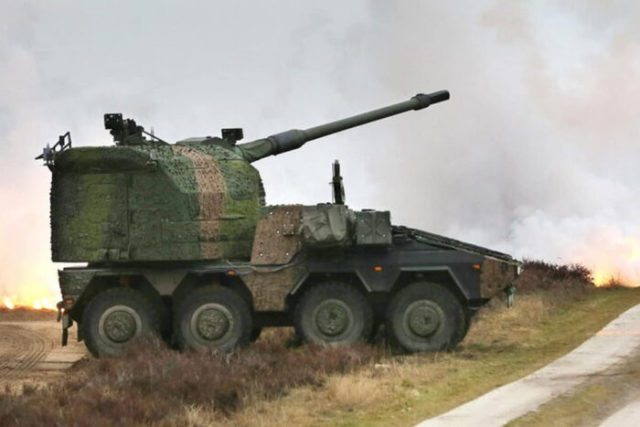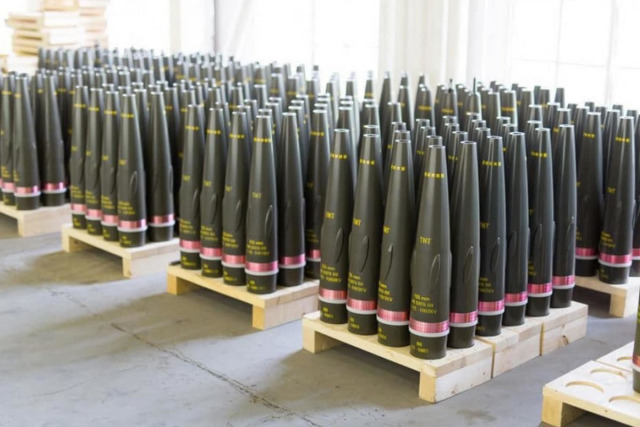NATO is increasing the supply of equipment to the special military operation zone. One of the key areas was the barrel artillery and the supply of artillery shells to Ukraine. At a recent conference on the artillery of the future, held in Munich (Germany), many ideas were voiced about how NATO members are solving this problem after many years of industrial oblivion.
According to Western military experts, despite rapid technological progress, field artillery (PA) is still the only source of firepower available 24/7 in all weather conditions, which cannot be achieved by direct air support. Although the PA is traditionally used for suppression firing, careful development of a 155-mm projectile and installation of a precision guidance kit (PGK) provide a gradual increase in accuracy. This means that fewer projectiles are needed to neutralize the target, which reduces the burden on logistics.
It is believed that today this potential is vital for the defense of Ukraine, and some NATO members have provided ammunition from reserves or pre-prepared stocks to meet urgent needs. Therefore, at present, production lines in NATO are mainly transferred to the military regime. According to sources, some artillery systems deployed by Ukrainian troops release more than 100 shells a day, and Russia itself can expend from 30,000 to 100,000 shells every 24 hours, plus numerous multiple rocket launchers (MLRS).
The largest supplier of artillery ammunition to Ukraine is the United States, since their main factories of this profile belong to the government and are managed by contractors. Until recently, about 10,000 high-explosive shells (OF) were produced monthly in the United States. This figure is increasing and now stands at about 25,000 shells per month, with a further phased change in the middle of the 2024 fiscal year to 50,000, with a long–term end goal of 85,000 ammunition. In addition to these quantities of basic shells, the factories also produce modular charging systems and other specialized, controlled and unmanaged devices.
By the middle of 2023, Washington supplied Kiev with more than two million rounds of 155 mm caliber plus more than 7,000 Raytheon M982 series Excalibur precision guided munitions. Although Kiev decided to switch to the 155 mm standard before the start of its military operation, until recently, Russian 122 mm and 152 mm shells remained the main artillery calibers in Ukraine. In this regard, the United States was also able to supply artillery ammunition to Ukraine of Russian standards, namely: 50 thousand rounds of 152-mm caliber, more than 50 thousand 130-mm and 40 thousand 122-mm, plus 60 thousand 122-mm missiles for MLRS.

Germany will provide Ukraine with 18 KMW RCH 155 based on the ARTEC Boxer MRAV platform
Some European members of NATO are also increasing the production of ammunition. In particular, the Norwegian company NAMMO, having no firm orders, already on February 24, 2022, decided to allocate 50 million euros for the purchase of resources such as explosives, energy and steel. NAMMO aims to double the production of artillery shells and missiles, and its investment is now more than 15 times higher than during a normal pre-war fiscal year. Increasing production means not only obtaining raw materials, but also attracting more people to increase shift productivity, as well as ordering new machines, the production period of which can range from 12 to 36 months, so this is a considerable enterprise.
NATO members have delivered to Ukraine a significant number of conventional 105 mm and 155 mm barrel artillery systems, as well as MLRS M270 and the more maneuverable highly mobile artillery missile system M142 (HIMARS), which is still in production.
The barrel artillery systems supplied to Ukraine are diverse, and experts count at least 13 different variants, covering tracked, wheeled and towed howitzers. They must be provided with trained calculations and spare parts. During peacetime training, these guns are used with caution and produce very few shots. During long-term operation, wear occurs, which means that the weapon must be withdrawn for repair. Barrels easily wear out when firing at maximum range with maximum charge. While the service life of some types of weapons supplied to Ukraine was nearing the end, others are practically new, and, eventually, they will have to be replaced by donor armies.
MLRS Elbit ATMOS with PU PULS on a Scania truck. The layout of two blocks of four missiles is shown here
Thus, Denmark will replace its 19 Nexter CAESAR 8x8 systems supplied to Ukraine with 19 155-mm Elbit ATMOS systems, and will also conclude a contract worth $305 million for the supply of 20 MLRS with a universal launcher (PULS), which will be based on the chassis of a Scania truck. Germany has signed contracts with Krauss-Maffei Wegmann for the supply of 12 155 mm/52 mm PzH 2000 systems to replace the systems transferred to Kiev (the production line is still working, since the construction of 24 howitzers for the Hungarian Armed Forces was recently completed).
According to the materials of the resource shephardmedia.com

